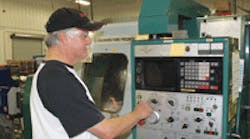North Carolina's once-mighty textile and apparel workforce unraveled in dramatic fashion in the 1990s as globalization and technology lessened the need for domestic labor. Between 1996 and 2006 textile and apparel employment in North Carolina dropped 65% from 233,715 workers to 80,232 employees, according to Duke University's Center on Globalization, Governance & Competitiveness.
The impact reverberated through the Appalachian Mountains to the town of Murphy, N.C., where a Levi Strauss & Co. plant closed its doors for good in 1999. Several more plant closings followed in the Murphy area, including a machine tool facility, a furniture plant and another textile mill, says Brian Spikes, plant manager at Snap-On Inc.'s Murphy manufacturing facility.
The shuttered plants were bad news for the region but provided a decent-sized labor pool for Snap-On when in 2000 the power tools manufacturer opened a facility in Murphy. Although the workforce was filled with eager, hard-working individuals, many lacked the skills the plant needed to operate effectively.
Snap-On's challenge was not unique. Manufacturers and workforce-development organizations have been clamoring for years that policy makers and educators must do something to address the skilled-labor shortage in the United States. But, curiously, manufacturers often exclude themselves from the workforce-development equation.
Help on the Way?
Employers spent an estimated $126 billion on employee learning and development in 2009, according to the American Society for Training and Development. But manufacturing consultant Michael Collins says manufacturers aren't doing enough. He's a proponent of apprenticeship-type programs that involve long-term investments by manufacturers to develop highly skilled workers.
"Manufacturers used to invest a lot in training," says Collins, president of MPC Consulting. "They're not doing it anymore. The people who build the machines for them know it because every day, all day, they get phone calls asking them how to start and stop machines."
Collins contends that manufacturers are too dependent on other resources to provide them with skilled workers. In his Jan. 25 State of the Union address, President Obama referenced the importance community colleges, such as Forsyth Tech in North Carolina, play in developing skilled workers. Obama called for preparing 100,000 new teachers in the science, technology, engineering and math, or STEM, fields. One week later educational testing organization ACT Inc., known for its college-entrance exam, released a 28-page report presenting the case for a national STEM skills credentialing system.
But Collins says the answer to the skills challenge ultimately lies with manufacturers. "They're cry-babying about the lack of skilled workers, but they're not investing in them," he says.
Partnering for Success
Snap-On didn't wait for someone else to produce the type of workers the company needed for its Murphy plant. The company collaborated with nearby Tri-County Community College and other area manufacturers to develop a machinist training program. Between 2005 and 2006 approximately 65 machine operators, accounting for about two-thirds of the plant's machining staff, participated in the paid-training program, Spikes says. The company invested about $125,000 in the training and paid for the instruction through various grants.
Instructors conducted the training at Snap-On's facility, so employees did not have to leave the plant, Spikes says. About 25% of the workers attending the program received a journeyman's certificate while the other employees took courses tailored to the individual skills they needed to operate their machines, Spikes says.
The plant satisfied its skilled workforce needs through the program and is utilizing a similar concept to train mid-level managers and front-line supervisors. Senior plant leaders view the program as an effective way to develop homegrown talent rather than waiting for skilled workers to come to them.
The program at Tri-County has since evolved into a full-fledged associate's degree track that provides Snap-On and other manufacturers in the area with a pool of skilled workers, Spikes says.
One of the operators who completed the two-year program was Lynn James. She says the experience provided her with critical knowledge about her job function that she likely wouldn't have received on the plant floor. "It was very beneficial because when you're trained on the floor people sometimes skip a step because they do it so much they forget to tell you so out of habit. Sometimes you're not taught things in baby steps like in the classroom where you're able to study at your own pace," says James who's worked at the plant for six years.
Likewise, machine operator Pete Carter says the program helped him understand how his machine operates and aided his ability to troubleshoot problems as they arise rather than seeking assistance from another worker. "It makes you feel like you have a little more responsibility when you can set up your own machine and not have to ask somebody to do things," he says.
The company also assigns the students to a mentor who meets with them regularly and provides coaching and support throughout their development. The students have goals and targets they must meet and a variety of ongoing training and education within their specific function and across Siemens. At the end of the internship, Siemens places qualified students in an area where the company determines they're most likely to succeed. "By the end of three years we have a highly functional, skilled employee," Dulaney says. "For the first three years they're given intensive support and help and we find there's greater success, and they become long-term employees."
Despite the company's efforts to recruit and retain talent, as of February it still had approximately 2,000 positions to fill, mostly in engineering, IT and manufacturing, Dulaney says. "We are not where we want to be," Dulaney says. "There's no question this is a challenge. There is a war for talent, and all companies in industry are in it whether they know it or not."
See Also:
• IW's Blueprint for Manufacturing Success
• Leadership Starts at the Top
• Average Isn't Good Enough
• Creating High-Value Supply Chains
• What's Missing in Improvement Initiatives




